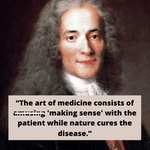Help….why do I still hurt?
Why do I still hurt?
Why is it not going away this time?
Why am I so sensitive?
Why does it keep happening?

People want answers
These are all questions that people regularly ask regarding their pain and injuries and they want to know a reason why. The bottom line is people want answers and in the absence of satisfactory answers will often jump to the worst possible conclusion.
Perhaps questions like these are indicators for the need for a different type of explanation beyond the pathoanatomical model?
Uncertainty
Uncertainty can be present in both acute and chronic pain. Mishel first proposed this in the “theory of uncertainty of illness” HERE. Uncertainty is a cognitive stressor and can be at its height during the diagnosis phase. This was defined as “an inability to determine illness related events”, the sufferer is unable to estimate what the issue is and unable to accurately predict what the outcome will be.
Mishel outlined 3 major points in the “theory of uncertainty of illness”:
- Antecedents of uncertainty- Things that occur previously to the illness. These can affect the patient's thinking such as pain, prior experiences and perception.
- Appraisal of uncertainty- Procedure of placing a value on the uncertain situation.
- Coping with uncertainty- Activities that are used in dealing with uncertainty.
Uncertainty has been linked with increased pain sensitivity, increased psychological distress and maladaptive coping HERE. Higher levels of disability and depression were found in LBP patients who felt their pain was due to diagnostic uncertainty HERE. HERE we see experimental data on uncertainty having an effect on the pain people experience.
Getting an answer
The perception can often be an answer or a diagnosis hopefully provides us with a pathway of what to do next and a fix, solution or a cure. Answers are often quite abundant, they are given out by all manner of therapists, trainers, medical doctors and of course everybody’s favorite doctor….doctor google. A key aspect in the expectation of recovery, a very important factor in actual recovery HERE, is a diagnosis and part of this includes diagnostic imaging HERE. Unfortunately we also know that it is not as simple as that HERE.
Without a clear diagnosis we may see expectations of recovery also diminish. We do as well as we think we will do! HERE.
Increasing stress and pain have a negative relationship, uncertainty can increases psychological stress and therefore potentially leads to increased pain levels too. Higher levels of acute pain have been cited as a risk factor for the development of chronic pain HERE.
Unfortunately there is lots we still don’t know and may never do, many painful situations have an unclear cause and diagnosis, and symptoms can be unpredictable.
Potentially this is why we have so many theories and syndromes that try and fill the gaps by supplying us with information about our postures being ‘bad’, joints being out of place or having dysfunctional movement patterns. In situations where people demand answers it is easy to reel off a basic, simple but often untrue explanations. Read more HERE and HERE. Although uncertainty maybe reduced it can be replaced by negative beliefs that cause more stress or negatively modify behaviours such as the avoidance of movement or reliance on being ‘put back into place’ by their therapist.
Maybe the answer, in part, with the scenarios that arise from these types of questions lies in understanding more about the myriad of changes that can occur within the systems that are involved with the experience of pain itself. In the absence of a plausible explanation the myths that pervade about the human body can continue to flourish and fill the void that people desperately want filled. The premise of pain education in essence is separating the pain someone experiences from the state of their bodies and not simply being reflective of the state of the tissue. Pain not being a measure of increasing harm.
This reconceptualization of what the problem might be really is a tough thing to be able to do. The question is are simple metaphors enough? How far does our knowledge have to go to really help people?
That of course may depend on the person, their education level and how much they really want to know. For some the science may baffle and bemuse and be counter productive as we often see in response to scan reports. Others may need the level of detail to high to make it believable and plausible. Finding the balance between being potentially too superficial and metaphorical and too heavy and science based is important but tough.
Whatever the route you take it is unlikely to be quick or simple with epiphanies all over the place.
Einstein told us “if you can’t explain it simply you don’t know it well enough” but also left us with “ make it things as simple as possible but no simpler”. Maybe these quotes sums up explaining pain quite well. Sometimes it needs to be simple and other times complex things must remain complex.

Perhaps we need layers to how we explain complex things like pain. Superficial metaphors and stories to help with concepts and backed up by a deeper knowledge of changes that can occur at multiple levels from the periphery, dorsal horn, spinal cord and up in the brain too.
Maybe this is why we have more recent problems with some of the issues surrounding the idea, or mantra as some have described it, that ‘pain is in the brain’ and the negative influence that that can have if the recipient misconstrues it as a purely psychological issue HERE. There are very physical and biochemical changes that can occur and discussing these as well as psychological factors might help fulfill some of the more uncertain aspects.
Armed with knowledge and how to get it across
The key to reassurance, a most powerful pain killer –Gifford, and that there really is nothing serious maybe the ability to perform a good clinical exam and being able to speak from a position of confidence that everything is likely to be ok.
Louw et al discuss the need for a good clinical exam in their recent paper HERE. Making sure that this base is covered before moving and finding out if someone is “interested in finding out why they still hurt”.
We have to appreciate that people may not need or want to know more about why they hurt. This aspect should not be seen as standalone or sufficient for recovery in the majority of situations but instead part of a multidimensional approach to care. Education seems to be more effective when combined with other stuff. Does this suggest that pain is not "in the brain"?
But if it is required is the key to reconceptualising also to have a similar level of knowledge and confidence about the subject that you are espousing on?
Wijma et al HERE look at classifying the type of pain to be then able to give a more detailed diagnosis of the source. They look at classifying pain as being mechanism based, the classification being based on history and sensation as nociceptive, neuropathic or central sensitized. This allows a pathway to explain the mechanisms involved in the pain rather than a more traditional pathoanotomical model of damage or alignment driven pain.
Nijs et al wrote a great paper HERE and also Lotze & Moseley HERE on the subject.
A criticism of research is bridging gap between academia and therapist and then between the therapist and person and being able to provide applicability. This can prove challenging in the area of pain with topics such as the level of complexity of the biochemistry and there may not be a substitute for having a decent grasp of the underpinning science.
The point of the blog is that people want a thorough explanation. Is don’t worry about pain enough?
Pain is an alarm!
Pain is in the brain!
It’s a perception!
Pain is helps us to protect!
Sometimes it goes a bit wrong!
Someone will always ask why?
So we have to be able to explain how and why it might be amplified. The mechanisms underpinning the plastic changes that happen peripherally to terminal endings and previously silent receptors, changes at the dorsal horn with receptive fields and available synapses and supra spinally to with increased attention to incoming information, changes in the sensory cortex and strengthening of neural connections.
Stress can come from another conflicting piece of information making the situation uncertain again. Finding the right place on the continuum between simplicity and complexity for the individual maybe the key. This can be tough if the knowledge base lends itself to the simple end.
Another challenge is can you make it FUN. People probably switch off with any boring explanation. How we get things across is probably MORE important than actually what is said!
The use of visual representations and diagrams can help. We could show multiple layers of processing in the CNS or more open doors in the dorsal horn quickly with a basic picture. It is no different from the model of the knee or back used in clinics the world over.
These are some basic tips for the practical application of pain science HERE.
Individualising
Rather than trotting out the same old patter each time it maybe good to use peoples experiences to individualize the interaction. Can we find part of someone’s history or story that lends itself to highlighting the unclear or trajectory nature of pain. This could be in contrast to scan results that can remain relatively unchanged over extended periods of time.
Does their pain correlate with periods of extreme stress or ease over the weekend or on holiday?
Have previous treatment methods aimed at the diagnosis helped over the longer term? Can we explain HOW they may have helped in the short term?
Why did picking up a biro cause their back pain to flare up but going to the gym did not?
Did their back pain flared up without any apparent stimulus or adverse event?
Key points
- People WANT an explanation or diagnosis
- Uncertainty is a stressor
- Expectation of recovery is a big deal
- Misinformation fills the gaps very nicely
- Simple explanations can be good and bad
- A Good grasp of the science is ALWAYS good
- Individualising helps










Leave a Reply
Want to join the discussion?Feel free to contribute!